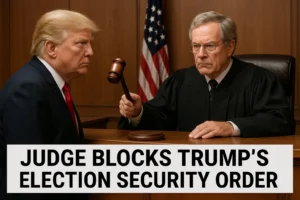Introduction
In a decision that has sent shockwaves through American politics, a federal judge has blocked Trump’s election executive order, marking one of the most significant legal battles of 2025. The order, introduced as a measure to “strengthen election integrity,” faced immediate criticism for overstepping constitutional boundaries and threatening state autonomy. Its rejection now stands as a pivotal moment in the ongoing debate about democracy, presidential power, and the balance between state and federal authority in U.S. elections.
Background: What Was in Trump’s Election Executive Order?
The executive order aimed to overhaul election oversight at the federal level. Among its key provisions were:
-
Expanded federal audits of state election results
-
Stricter voter ID and ballot verification rules
-
Increased federal monitoring of voter registration systems
Trump and his supporters claimed the order would safeguard elections from fraud and foreign interference. However, opponents—including civil rights groups, state officials, and legal scholars—argued that it undermined state authority and placed unnecessary restrictions on voters.
Why the Court Blocked the Order
The ruling highlighted the limits of presidential power under the Constitution. The judge found three primary issues with the executive order:
-
Federal Overreach – Elections are primarily managed by states, not the executive branch.
-
Checks and Balances – Implementing sweeping election reforms without congressional approval was unconstitutional.
-
Voter Rights – Provisions risked disenfranchising voters, especially in minority communities.
According to the Los Angeles Times, Democrats welcomed the ruling as a safeguard against authoritarian control, while Republicans denounced it as judicial interference in election security.
Political Fallout: A Deepening Divide
The court’s decision has intensified partisan divides, fueling debates across political and media landscapes.
-
Democrats: Framed the ruling as a victory for democracy and civil rights. Many argued the order was a veiled attempt at voter suppression.
-
Republicans: Condemned the judge’s intervention, portraying it as an obstacle to securing fair elections.
-
Independent Voters: Left questioning whether such measures improve or undermine trust in the electoral process.
This polarization will likely shape campaign narratives heading into the 2025 election cycle, with both parties using the ruling to rally their bases.
State vs. Federal Power: The Core Debate
The ruling reignited a longstanding debate: Who should control U.S. elections?
-
Federal Oversight Advocates argue that national standards are needed to ensure uniform fairness and prevent fraud.
-
State Authority Defenders maintain that states must retain control, citing their constitutional responsibility to administer elections.
By blocking the executive order, the court reaffirmed that states remain the primary arbiters of election laws, limiting how much influence presidents can exert through executive actions.
Long-Term Implications for American Democracy
The decision carries long-lasting consequences that extend beyond Trump’s political career:
-
Limiting Presidential Power – Future presidents may face tighter restrictions on altering election processes via executive order.
-
Judicial Precedent – This ruling will serve as a benchmark for future election-related lawsuits.
-
Campaign Strategy – Candidates in 2025 and beyond will use this ruling as a talking point in debates about democracy.
-
Public Trust – While some view the decision as a safeguard, others fear it reduces election security.
Infographic Idea: Timeline of Trump’s Election Order and Court Battle
To make this story more accessible and shareable, create an infographic with:
-
Order Signed – Trump announces the executive order.
-
Lawsuits Filed – States and advocacy groups challenge the order.
-
Judge’s Ruling – The court blocks the order.
-
Political Reaction – Democrats celebrate, Republicans protest.
-
Future Impact – Precedent set for election law battles.
Infographics like this can boost engagement, attract backlinks, and improve your site’s SEO authority.
SEO Strategy: Turning News Into Traffic
This ruling is a perfect example of how trending political developments can become pillar content for blogs. By focusing on the keyword “Trump election executive order blocked” and related long-tail keywords, you can increase visibility. Suggested keyword phrases:
-
“Trump election executive order blocked ruling 2025”
-
“judge strikes down Trump’s election security order”
-
“federal vs state authority over elections”
-
“impact of blocked election order on U.S. democracy”
Adding authoritative references like the LA Times strengthens credibility, while internal linking to resources on RankRise1 enhances SEO structure.
Building Natural Backlinks Through Authority
To further optimize your site’s reach, focus on generating natural backlinks:
-
Media References – Journalists often cite blogs that provide clear timelines and analysis.
-
Educational Resources – Infographics and case summaries are frequently shared by schools and universities.
-
Research-Based Posts – Publishing statistics on voter turnout and legal precedents can attract citations from other websites.
By positioning your blog as a trusted source of analysis, you increase the chances of authoritative backlinks from news outlets, academics, and advocacy groups.
Conclusion: A Defining Case for 2025
The court’s decision to block Trump’s election executive order is more than a legal ruling—it is a defining moment in America’s democratic journey. It underscores the limits of executive power, reaffirms the role of states in managing elections, and highlights the judiciary’s responsibility to safeguard constitutional principles.
As the nation heads into another heated election cycle, this ruling will remain a central theme in political debates, campaign strategies, and legal analysis. For bloggers and digital publishers, it offers a unique opportunity to create authoritative, SEO-optimized content that not only informs readers but also strengthens site traffic and online credibility.

